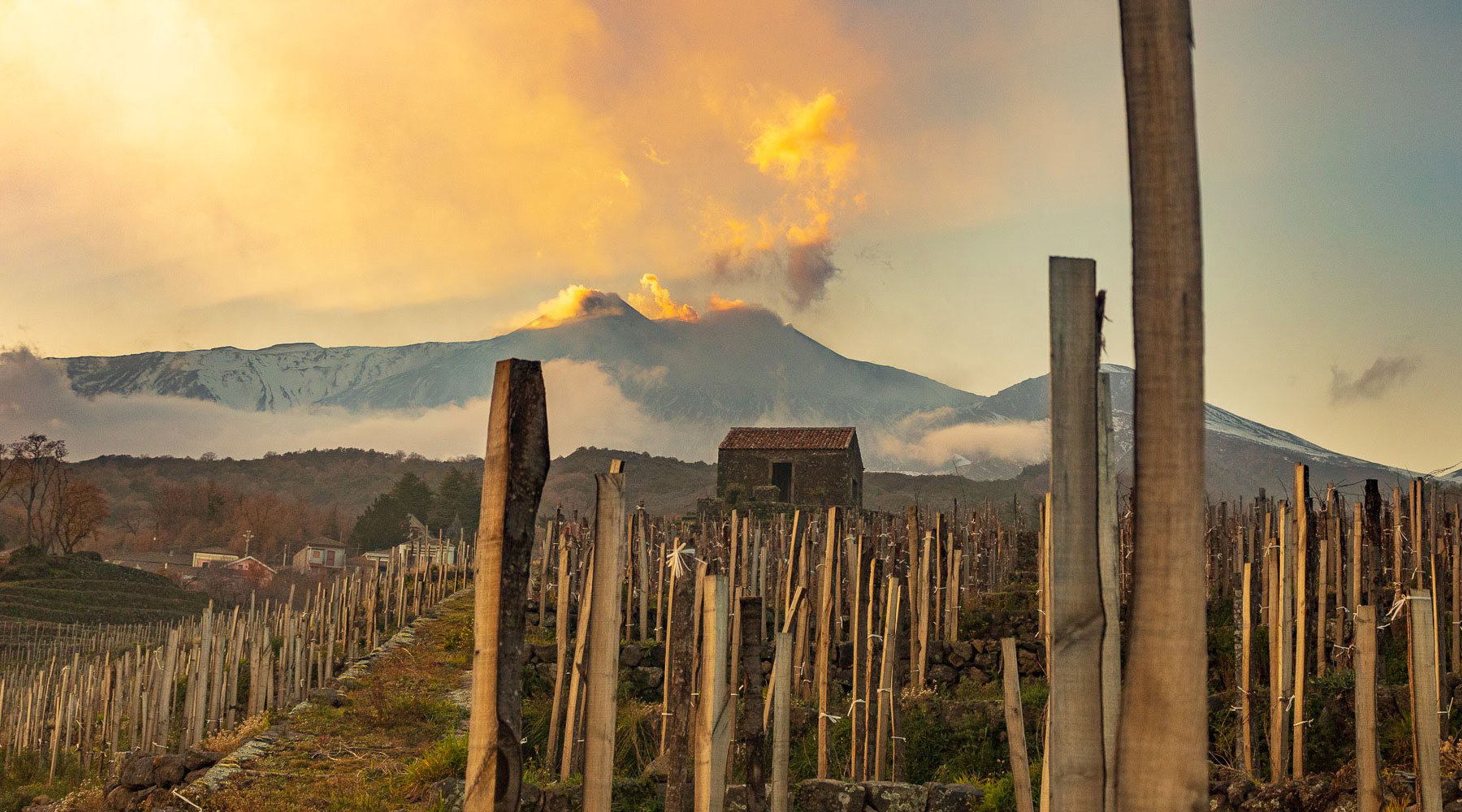
Nestled on the eastern coast of Sicily, the Etna wine region offers a unique and compelling narrative for wine enthusiasts. Centred around Europe’s largest active volcano, Mount Etna, this area combines a rich history, distinctive terroir, and a growing reputation for exceptional wines.
Geography and Terroir
Mount Etna, standing at 3,400 metres, is Europe’s tallest active volcano. Its colossal presence significantly influences the region’s climate and soil composition. The volcanic activity results in soils that are rich in minerals like phosphorus and magnesium, which are vital for vine health and grape development. Frequent eruptions deposit lapilli, or black ash, creating a nutrient-poor yet mineral-rich foundation ideal for viticulture. These soils are constantly evolving due to the ongoing volcanic activity, which adds a layer of dynamism to the terroir.
Despite being located in a typically hot region, the climate in Etna is regulated by the altitude of the vineyards, which range from 450 to 1,100 metres above sea level. This altitude, along with the proximity to the sea and the rainfall generated by the volcanic mountain, creates a more temperate climate than one might expect from a southern Mediterranean location. The combination of high altitude and volcanic influence results in cooler temperatures and a longer ripening period, which is ideal for the development of complex and balanced wines.
Vineyards on Mount Etna are found in a circular pattern around the volcano, though the western slopes are largely excluded due to their steep gradients. The region is divided into approximately 133 contrade, which are similar to the French concept of lieu-dit or cru. Each contrada offers distinct expressions of the local terroir, further contributing to the complexity of Etna’s wines. The Alcantara River also plays a role in the region’s soil diversity by providing some clay, creating a natural boundary between the black and white soils of the area.
Historical context
Viticulture on Mount Etna has a rich and deep history that spans over two millennia. Evidence suggests that vines were first cultivated on the slopes of the volcano during the Neolithic era, and the practice was further developed by the Greeks and Romans, who introduced various grape varieties, including Grecanico, now known as Carricante. While the region faced challenges, such as the phylloxera epidemic of the early 20th century, it has experienced a renaissance in recent years, regaining its reputation as a top-tier wine-producing region. This revival has been bolstered by a renewed interest in native grape varieties and a focus on sustainable viticulture.
Grape varieties
The Etna wine region is known for its unique blend of red and white grape varieties. For red wines , the principal grape is Nerello Mascalese, a thin-skinned variety with an aromatic profile that has often been compared to Pinot Noir and Nebbiolo. Nerello Mascalese produces wines with high acidity, vibrant red fruit notes such as cherry, raspberry, and red currant, and a delicate floral character reminiscent of rose petals. These wines are also known for their more pronounced tannic backbone, which sets them apart from lighter reds like Pinot Noir . The grape is late-ripening, which contributes to the complexity and ageing potential of the wines. Nerello Cappuccio, another red variety, is typically blended with Nerello Mascalese to add flesh, colour, and power to the wines.
For white wines , the region is predominantly known for Carricante, a variety prized for its vibrant acidity and minerality. Carricante wines are typically characterised by citrus and orchard fruit flavours, with subtle herbal and floral notes that reflect the volcanic soil in which they are grown. Carricante’s crisp acidity makes it an ideal match for seafood and other Mediterranean dishes, and it is often described as one of the most exciting white varieties emerging from Sicily. Another important white variety in the region is Cataratto, which is more commonly used in blends. Cataratto is a versatile variety, producing wines with refreshing acidity and delicate fruit flavours, although it is less complex than Carricante. Its role in Etna’s wines often adds a softer texture and roundness to blends, balancing the sharper acidity of Carricante.
Food pairing
Etna wines, with their vibrant acidity and distinct minerality, offer excellent versatility when paired with food. The crisp, citrus-driven Carricante is a perfect match for fresh seafood dishes like grilled shellfish, calamari, or a Mediterranean fish stew. For red wines, the aromatic Nerello Mascalese, with its red fruit notes and elegant tannins, pairs beautifully with roasted meats, such as lamb or game, as well as pasta dishes with rich tomato-based sauces. The fleshy Nerello Cappuccio, often blended with Mascalese, enhances heavier meat dishes like braised beef or aged cheeses, bringing depth and structure to the pairing. These wines’ balanced acidity and complexity make them ideal companions for a wide array of Sicilian and Mediterranean cuisine.



























